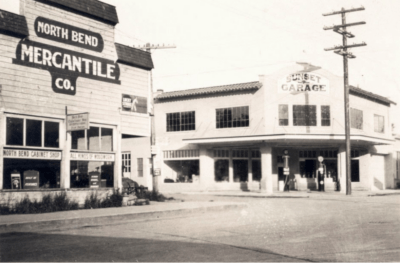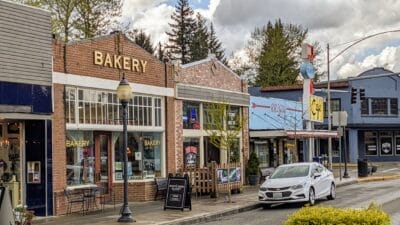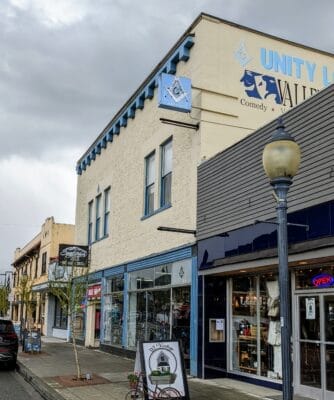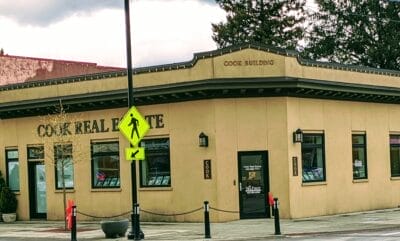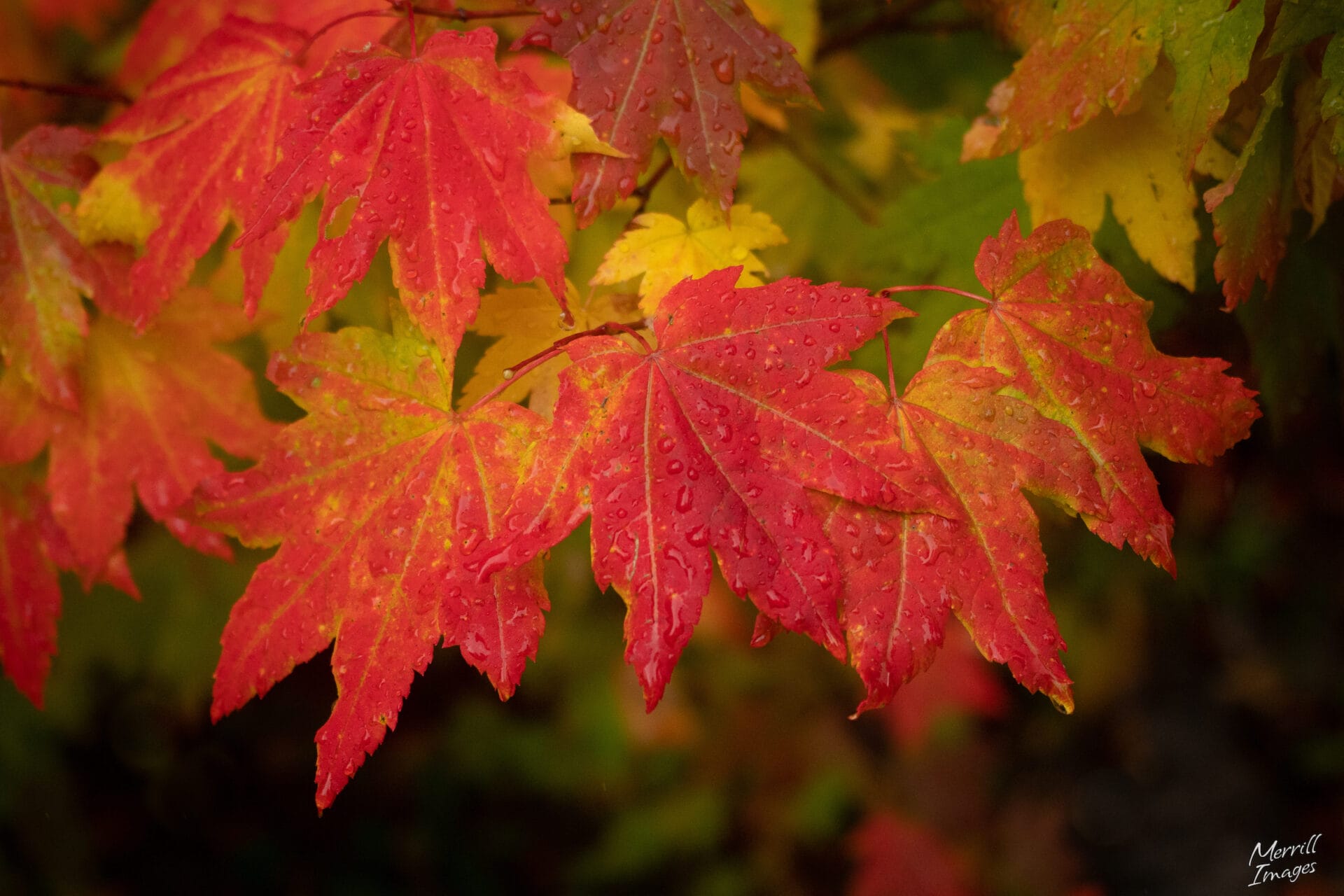North Bend Historic Walking Tour
Enjoy a stroll through historic downtown North Bend and take a walk back in time. See how the opening of the Sunset Highway – the first automobile route across the Cascades Mountains – dramatically changed a small town by giving it an important role as the last stop before Snoqualmie Pass. North Bend bargained with the State of Washington to keep the main highway (The Sunset Highway) going through the town. The state had originally planned to bypass the town, but North Bend prevailed. The tour takes you past more than a dozen historic structures – from cafes, to hotels, to bakeries, and a movie theater. Click on the links to see historic photos and learn more. Itinerary designed with generous support from 4Culture King County Lodging Tax.
Historic photos credits for this tour: Snoqualmie Valley Historical Society
Itinerary
-
Sunset Garage
Start your day at the intersection of North Bend Way and Bendigo Boulevard in downtown North Bend.
The building you’ll see on the western corner of the intersection was known as the Sunset Garage, constructed in 1929. With the completion of the Sunset highway in 1915 over Snoqualmie Pass, North Bend became the motorist’s crucial last stop for food, gas, and lodging before crossing the Cascades. The Sunset Garage, originally built as a mercantile store, quickly converted to the garage to service cars traveling the highway.
In the photos below, the garage is on the right.
-
Thompson's Cafe
Across the street you’ll see Twede’s Cafe. Built in 1941 by Roy Thompson, this building originally housed Thompson’s Cafe. It witnessed World War II, the Depression, and the boom of the timber industry. In the 1950’s, the business changed hands and became known as the Mar-T Cafe, continuing as a regular stop for locals and mountain pass travelers. In 1990, on a scouting trip to find a location for his new series, director David Lynch discovered this cafe and the Snoqualmie Valley and decided to have them serve as settings for his new show. He filmed the now famous TV series “Twin Peaks” which immortalized the cafe’s cherry pie and “Damn fine cup o’ coffee!”
Check out our Twin Peaks Itinerary for more filming locations in the Valley.
-
Kelsko Meat Market
Continue walking east to the next building. Originally built in 1920, the Kelsko Meat Market added frozen food lockers in the 1940’s when many homes still did not have freezers. Later this building became a local hangout called The Del – run by the Dorothy Scott family – selling hamburgers, soft drinks and ice cream.
-
Bellinger's Bakery
Next door you’ll find what was once the Bellinger Bakery, built in 1928 and owned by Carl Bellinger. Remarkably it has remained a bakery and famous North Bend stop throughout the years. In 2014, 4Culture awarded Georgia’s Bakery a Landmarks Capital grant to restore the original facade of the 1928 building. The process involved the removal of an alpine facade, a façade installed by many North Bend businesses in the 1970’s to give downtown a Bavarian feel. Today the bakery operates as the North Bend Bakery.
-
Upper Valley Masonic Lodge
Two doors down you’ll find a large building. The Upper Valley Masonic Lodge – Unity Lodge #198 – occupies the top floor of this 1912 building (the larger building under construction in the photograph). Gene Hill’s grocery store occupied the floor level of the building. Gene’s wife – Ada Snyder Hill – founded the Snoqualmie Valley Historical Society.
Only a couple buildings remain from the Railroad Era, this being one of them.
Read the History of Unity Lodge #198 as prepared for its Centennial celebration.
-
McGrath's Hotel and Cafe
Continue east to the building on the corner that currently houses the Iron Duck Public House. The McGrath’s Hotel building has significant association with the history of highway and automotive transportation in Washington State and the development of tourism, recreation and commerce in rural King County.
With its particularly prominent design features in the historic center of North Bend, the building serves as an exceptional example of commercial architecture executed in the Spanish Colonial Revival stylistic design mode.
The construction of the new hotel in February of 1926 coincided with a period of increasing auto tourism along the Sunset Highway and was completed “in time for the early spring travelers.” After the hotel unofficially opened in mid-February, the McGraths held formal opening festivities on March 2, 1926. These included a complimentary evening buffet lunch for the community and music provided by Miss Queen’s Orchestra, a live three-piece band.
Through a newspaper notice, the McGraths had cordially invited the community to attend the festivities. Some 200 guests accepted the hospitality, toured the hotel and danced on the cafe’s maple dance floor from 8:00 p.m. until midnight. Managed by Mr. and Mrs. McGrath, it was the largest and most modern hotel in North Bend and the vicinity. Read more about this building’s history and context in the National Register of Historic Places.
-
North Bend Timber Company Office
Continue east for one block to the building on the corner of Ballarat Avenue that houses the North Bend Bar and Grill. This building, originally a small log structure constructed in 1924, housed the office for the North Bend Timber Company. The Company had been located further upstream from North Bend along the South Fork in a town called Edgewick. You can read the story of Edgewick and how it was swept away.
After Edgewick’s destruction, the Timber Company took a while to settle its lawsuits and figure out next steps. In 1923 it started logging in the Middle Fork and built this office in town as its administrative hub.
After the St. Regis Pulp and Paper Company acquired the North Bend Timber Company in 1944, the little log building was sold and converted to a restaurant. After construction of a large adjacent structure, the log building was converted to a dance floor, storage, and restrooms. Some of the log walls and old stone fireplace remain.
-
North Bend Train Depot
Take a right on Ballarat and head south to the North Bend Train Depot. The North Bend Depot is a copy of the original train station.
The North Bend area remained largely inaccessible to commerce until the arrival of the Seattle, Lake Shore & Eastern Railroad in 1889. Early settlers William and Mary Taylor platted the townsite – first called Snoqualmie, later Mountain View, and finally North Bend in February 1889. They laid out North Bend Way parallel to the railroad.
You can still enjoy train rides from North Bend to Snoqualmie throughout the year run by the Northwest Railway Museum.
-
Sylvester's Bank
Head back to North Bend Way, turn left, and go one block to Main Street and the small concrete building that currently houses Cook Real Estate Services. The Bank of North Bend originally occupied this structure.
Earlier downtown photos show a predecessor wood frame bank building with a false front on the opposite side of First Avenue, one block further east. Issaquah banker W. W. Sylvester first organized that private bank in 1908. By 1911, the new concrete bank with its distinctive corner entrance had been erected there and appears on Sanborn Company insurance maps of that year. Sylvester’s Bank was incorporated in 1913.
C. Beadon Hall and his sister Isadore Hall purchased the concrete bank in 1923. It became part of Beadon’s Washington State Bank system, including banks at Duvall, Tolt and Snoqualmie. The North Bend Post reported in October of that year that “This Bank is Being Built Up.” A 1929 remodel enhanced the bank’s appearance with a heavy classical cornice, moldings above the corner entry, and ornamental lanterns.
With the widening of the Sunset Highway (now North Bend Way) through downtown North Bend in 1941, the bank received compensation for relinquishing land in the right-of-way including a sizeable amount to jack-up and move the concrete building to its current location.
Seattle First National Bank purchased Beadon’s bank corporation in the 1950’s and he retired to his home in Snoqualmie.
Learn more and see historic photos at Cook Real Estate Services history section.
-
Glazier's Drygoods
Continuing northwest to 112 West North Bend Way, constructed in 1941. Watt and Francis Glazier owned and operated it as Glazier’s Drygoods.
-
Lee Brothers Grocery Store and Servicemen's Memorial
Cross the alley for the next stop. This building, constructed in 1941, operated as Lee Brothers Grocery Store. The store operated from 1932 in a different building at the same address displaced by the widening the highway. Lee Brothers elected to build this Art Moderne structure rather than move the previous building.
In the adjacent parking lot, a temporary Servicemen’s Memorial listed the names of North Bend residents off fighting during World War II. As they returned home, their names were removed, and the memorial was eventually taken down after all of them returned home. In 2011, the Snoqualmie Valley Historical Museum, the local Veterans of Foreign Wars, and the Renton-Pickering American Legion built a Snoqualmie Valley Veteran’s Memorial in Snoqualmie to honor American veterans from all wars. It includes a centerpiece monument identifying Valley residents who lost their lives in the line of duty.
-
North Bend Theatre
Like many small towns, North Bend received its own theater in 1941. While most towns have either torn down or converted their theaters to other uses over the years, North Bend continues as a working and thriving family theater.
A reporter from the Snoqulamie Valley Record attended Opening Night on April 9, 1941. The article that follows appeared on the front page of the local paper the next day.
New Theatre Opens at N.B.: Many Marvel at Beautiful Interior-Lavish Appointments-Excellent Sound
The opening of North Bend’s new theatre Wednesday evening proved a gala affair. Guests were welcomed in the lobby by Manager and Mrs. Jay Tew and the builder Emmet Jackson and Mrs. Jackson.
The attractive foyer was made more beautiful by the arrangement of many baskets of flowers sent by associates and friends. The event developed into an “open house” with everyone visiting the power room and crying room and commenting on the handsome decorations and modern appointments before taking their seats.
The theatre which has been built, conforms to the latest standards in construction under the supervision of Wm. Blaisdell and Herbert Johnson. The building is 40 by 100 ft. of reinforced concrete and is the “last word” in theatre buildings. W.E. Stoddard of Meadowbrook is responsible for carrying out the interior decorative scheme – yellow and dark red being the predominating colors. With 412 deluxe seats, upholstered in red plush, it will be a real pleasure to watch the pictures.
Indirect lighting from beautiful fixtures at the sides of the main body of the theatre, and one of the newest innovations – a silver screen, back of the main red plush curtain, proved a surprise to everyone. This silver curtain, glistens in either gold or silver depending upon the lighting.
The furniture in the lobby, of cream colored leather, harmonizes nicely with the rich dark red carpet, the whole effect of the building and appointments being stream-lined in the most modern manner. The latest of sound equipment and air conditioning system, will insure patrons the acme of comfort. In fact, one might go on indefinitely describing the beauties of the new theatre and then not do it justice.
A large and beautiful Neon sign, which can be seen for a long distance has been erected in front of the theatre. Mr. and Mrs. Tew and Mr. and Mrs. Jackson are to be highly commended on the successful completion of so beautiful a building.
Read more about the history of the theater and renovations on the Theatre’s webpage.
-
McClellan Hotel
Head back to the intersection of Bendigo Blvd and North Bend Way and the building that currently houses Birches Habitat. Originally constructed in 1918, the building was split in 1941 and a portion moved down the block to become a tavern.
-
Snoqualmie Valley Historical Museum
Continue heading south back on Bendigo Blvd. and cross West Park Street to get to the Snoqualmie Valley Historical Museum.
The Museum has served Fall City, Preston, Snoqualmie, North Bend, Cedar Falls and Snoqualmie Pass for nearly 50 years. Exhibits include a rich collection of pioneer artifacts, farming in the Snoqualmie Valley, the Snoqualmie People, and a rotating exhibit. The Museum is a great resource for learning even more about the history of North Bend and surrounding area.
After visiting the Museum, enjoy coffee, a treat, or a meal at one of North Bend’s many charming businesses, perhaps one you strolled by on this tour!


